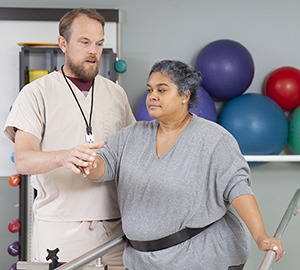After a stroke, a person may have trouble using all or part of the body. Often, the arm and leg on one side are weak, numb, or stiff. The inability to move a limb or body part after stroke is called paralysis. Muscles may also tighten up, making it difficult to stretch. This is called spasticity. Improving posture, range of motion, and strength are early treatment goals. Together, the rehab team helps the person progress from sitting to standing and walking.
Improved positioning
Proper positioning helps a person recovering from stroke regain lost movement. It also helps limit future problems. Correct body posture keeps the person from slumping. Proper positioning of arms and legs is needed, too. This prevents muscles near the joints from tightening (spasticity). Good body position is vital for a person who has weakness on one side of the body (hemiparesis). Proper positioning is also important for those who have lost awareness of one side of the body (called neglect).
Working the muscles
Getting the person out of bed is the next step. Physical therapists may start by gently moving the person's limbs each day. Simple stretches may help relax muscles that tighten or spasm. The person may be taught how to increase strength and range of motion. Many exercises prepare a person to do tasks. For instance, working to bring a hand to the mouth prepares them to use a fork or a toothbrush. Full range-of-motion exercises at least 3 times a day can also help reduce spasticity.
Standing again
At first, your loved one may be able to stand only briefly. If the legs are weakened by the stroke or from disuse, holding on to parallel bars may help. Leaning against a counter or a walker can also help the person stand longer. They can prepare to relearn walking by shifting weight from one foot to the other.
Walking again
Most people do walk again after having a stroke. Your loved one may start by walking between parallel bars. Some people use walkers for support. Others learn to use a cane. To help improve walking skills, some people may use a special type of treadmill or other equipment. Gradually walking farther and faster may help your loved one recover more completely.
Practical tips
Ask the rehab team how you can help. They may have you:
-
Align your loved one’s head, shoulders, and hips.
-
Support a limp arm, or gently straighten curling fingers.
-
Keep the person’s feet flat on the floor or on a footrest.
-
Approach from their good side when talking and handing your loved one items.


